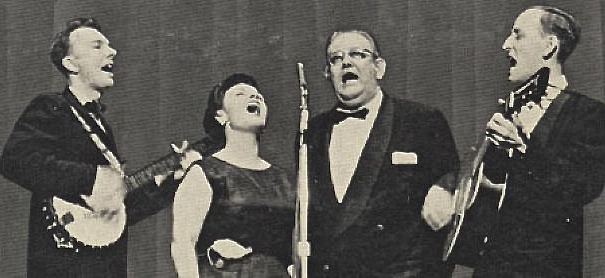|
The great folk scare . . .
Remembering the folk music revival of
the late 50s and early 60s
The odds are good that
each of us - every member of the Plank Road Folk Music Society - was
influenced by what came to be known as the American Folk Music Revival.
It's been referred to as
"The Great Folk Scare" - tongue-in-cheek by some, but quite seriously
by others who feared that folk music was just one more leftist plot to
bring down America.
It was a phenomenon that
began during the 1940s and peaked in popularity in the mid-1960s. But
Its roots were earlier with performers like Burl Ives, Woody Guthrie, Lead Belly, Big Bill Broonzy, Jean Ritchie, Cisco Houston and others enjoying limited popularity in the 1930s and 1940s.
The first wave
Folk music became more popular (and commercial) with The Weavers
- formed in 1948 by Pete Seeger, Lee Hays, Fred Hellerman and Ronnie
Gilbert. The Weavers had a big hit in 1950 with Lead Belly's "Goodnight, Irene"
- number one on the Billboard charts for thirteen weeks. This was
followed by a string of hit singles that sold millions, including "So Long It's Been Good to Know You" and "Kisses Sweeter Than Wine".
But the Weavers' career ended abruptly when they were dropped by their
record label because Pete Seeger had been listed as a "probable
subversive."
(Remember Grandpa from The Waltons TV show? He was a subversive as well!)

The Weavers topped the charts for 13 weeks in 1950.
In
the early and mid-1950s, folksongs were mostly heard in coffee houses,
at hootenannies and college-campus concerts. A few performers, such as Odetta and Harry Belafonte,
crossed over into the mainstream. Folk music was often associated with
political dissent, but now blended with the beatnik scene, including
poetry and jazz, and eventually led to the rise of individual
singer-songwriters.
1957 . . . and three guys from the West Coast
Folk purists may not love 'em, but the Kingston Trio
made a huge impact on the popularity of folk music. Dave Guard, Bob
Shane and Nick Reynolds formed the trio in 1957, and a year later they
were superstars.
Their style and
presentation were directly inspired by the Weavers - but they avoided
overtly political or protest songs and cultivated a clean-cut,
collegiate persona. Their first hit, "Tom Dooley",
went gold in 1958, selling more than three million copies. At one
point in 1959, the Trio had four albums in the Top 10 for five
consecutive weeks.
|
|
The Kingston Trio sold millions
of albums in the late '50s
|
The huge commercial success of the Kingston Trio spawned a host of groups like the Brothers Four, Peter Paul and Mary, The Limeliters, The Chad Mitchell Trio, The New Christy Minstrels and many more.
The revival at its height
The Kingston Trio's popularity would be followed by that of Joan Baez,
whose debut album reached the top ten in late 1960 and remained on the
Billboard charts for over two years. Baez's early albums contained
mostly traditional material and covers of melancholy ballads. Baez,
unlike the Kingston Trio, was openly political, and as the civil rights
movement gathered steam, aligned herself with Pete Seeger, Guthrie and
others.
A guitar, a harmonica . . . and that "unique" voice
In 1961, singer-songwriter Bob Dylan, was signed by Columbia. Dylan's first record
enjoyed some popularity among Greenwich Village folk-music
enthusiasts, but he was "discovered" by an immensely larger audience
when Peter, Paul & Mary had a hit with a cover of "Blowin' in the Wind".
|
| |
Bob Dylan in his Greenwich Village days
|
As
a result of the financial success of these high-profile commercial
folk artists, record companies began to produce records by a new
generation of folk revival and singer-songwriters - Phil Ochs,
Tom Paxton, Eric von Schmidt, Buffy Sainte-Marie, Dave Van Ronk, Judy
Collins, Bob Gibson, Tom Rush, Fred Neil, Joni Mitchell, Gordon
Lightfoot, John Denver, Arlo Guthrie, Harry Chapin, John Hartford and others. In
addition, many "less commercial" artists gained recognition, often
enlightening audiences to other musical genres such as blues, jug band,
bluegrass, country, old-time music and more. Some of these influential
artists included Doc Watson, The Stanley Brothers, Mississippi John Hurt, The New Lost City Ramblers, The Clancy Brothers, The Staples Singers and many more. Rock fights back . . . with an English accent
The British Invasion of the mid-1960s helped bring an end to the
mainstream popularity of American folk music. A wave of British bands
overwhelmed most of the American music scene - including folk.
Ironically, the roots of the British Invasion were in American folk -
specifically a variant known as skiffle, as popularized by Lonnie Donegan - and American blues, as interpreted by groups such as The Animals and the early Rolling Stones. Dylan goes electric! Oh, no!
Some say the "official" end of the Great Folk Scare occurred when
Dylan plugged in at the Newport Folk Festival in 1965. Many other folk
artists followed suit. Bands like The Lovin' Spoonful, The Byrds and The Mamas & Papas
- whose individual members had a background in folk music - were
getting recording contracts. "Folk rock" was born, and before long, the
public appetite for the acoustic music of the folk revival began to
wane. Legacy
By the late 1960s, folk music had returned to being more of a low-key,
aficionado phenomenon. But the acoustic music coffeehouse scene -
while limited - has survived; a prime example being our very own Two Way Street Coffee House, celebrating 45 years of continuous folk entertainment in Downers Grove! NOTE: Information
for this article was gleaned from my fading memory, but mostly from
copyright-free content on the Internet, primarily Wikipedia. (And we
all know everything on the Internet is true!) So, apologies for any
inaccuracies or blatant omissions. - Bill Lemos |